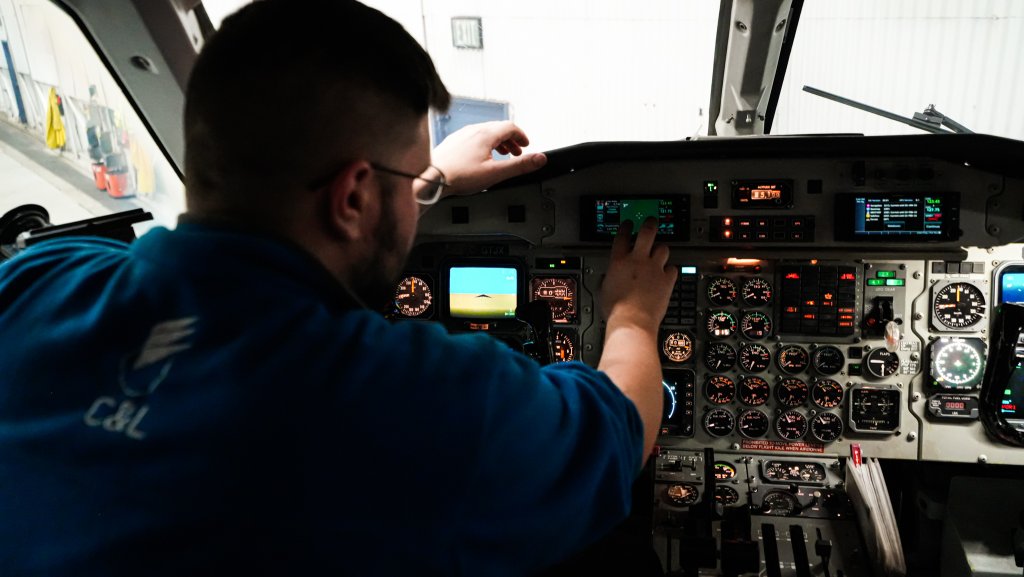Do you have an older aircraft and want to know if it can support an upgraded flight management system and landing approach? There’s been a lot of recent information on upgrading to an FMS/LPV system, so you may be wondering if the upgrade is necessary and, if so, what criteria you would need to meet for the installation.
We often get asked about FMS/LPV installations. In this article, we explain what an FMS/LPV system is, why someone might choose to upgrade, and what options are available based on an aircraft’s current FMS capabilities.

What is an FMS/LPV?
A flight management system (FMS) is a specialized computer system on board the aircraft that reduces the flight crew’s workload by automating various in-flight tasks. The FMS contains a navigation database, providing flight crews with data for navigation, performance, and aircraft operations.
LPV stands for Localizer Performance with Vertical guidance. It is becoming the most common landing approach at U.S. airports. This precise landing approach requires a Wide Area Augmentation System (WAAS) enabled system. The aircraft must be equipped with either a dual WAAS/SBAS (Satellite-Based Augmentation System) LPV capable FMS or a single FMS with a standalone LPV monitor.
Why Upgrade to an FMS/LPV System?
Improved navigation systems, such as WAAS/SBAS are becoming more prevalent. Most airports are adopting WAAS with LPV, LNAV (Lateral Navigation), VNAV (Vertical Navigation), or LP (Localizer Performance) capable landing approaches. Older landing approaches, like ILS (Instrument Landing System), are being phased out at airports as LPV capabilities become more widespread.
Criteria for FMS/LPV Upgrade
Whether your aircraft can have FMS/LPV capabilities installed will depend on what FMS is currently in the aircraft. The installation agency will need to ask the following questions to know what upgrade option to choose:
- What type of FMS is currently installed on the aircraft? Is it a single or dual FMS system?
- Is the FMS displayed laterally and vertically on the primary flight instruments?
- Is the aircraft currently coupled with autopilot both laterally and vertically from the FMS?
- What type of flight director and autopilot does the aircraft have?
- Is the aircraft equipped with an electronic flight instrument system (EFIS)? If so, what type?
How you answer these questions will help the installation agency determine what products to install on the aircraft. Review the following sections for possible upgrade options.
FMS/LPV Upgrade Options
The following examples – Universal Avionics and Honeywell – demonstrate the requirements for product installation based on the aircraft’s current FMS capabilities.
Universal Avionics
With Universal Avionics Systems, the UNS-1(x)W FMS requires either a dual system or an approved single FMS with an LP/LPV monitor installed to meet LPV requirements.

Universal Avionics Systems also implemented an FAA-approved document called “Engineering Assisted Field Approval Process” (EAFAP). This document allows authorized Universal Avionics dealers to work with their FAA/FSDO (Flight Standards District Office), allowing field approvals with the following guidelines:
- Aircraft must have existing Universal Avionics installed.
- Aircraft must already have VNAV displayed.
- Aircraft must already have VNAV coupled to the autopilot (if you desire a coupled LPV).
- The type of aircraft must have been previously approved. (See the table below for a partial list of approved aircraft from the EAFAP Table 2.)
After meeting the above requirements, the engineering department will provide the design for the dual FMS installation, single installation with an LP/LPV monitor, or both. Then, a shop will perform the installation. The engineering department will work with the FAA Designated Engineering Representative (DER) agency to approve this installation for vertical coupling with an FAA form 8110-3 and with an FAA flight test DER to approve LPV operation or integration. The FAA/DER then approves an airframe flight manual supplement (AFMS).
Watch: “Support Issues & Solutions for Universal Legacy FMS [webinar]”
Honeywell

The Honeywell WAAS/LPV capability is accomplished via an FAA/DER flight test engineer, supplemental type certificate (STC), or both. Honeywell and other manufacturers do not have an EAFAP like Universal Avionics for accomplishing installations. Therefore, you will have to use alternate methods to gain approval.
When an FMS/LPV Upgrade is Not Beneficial
The following situations demonstrate how upgrading to an FMS/LPV system may be less beneficial based on an aircraft’s existing systems.
First, if the EFIS, autopilot, or both are non-compliant, upgrade costs may exceed the value of the aircraft. This would make the upgrade an uneconomical choice.
Second, the upgrade may be unbeneficial for aircraft flying routes that support ILS landing approaches, where LPV is unnecessary.
Aircraft Specifications for FMS/LPV Upgrade
FMS/LPV upgrades are typically intended for older aircraft types (i.e., those specified in Universal Avionics’ EAFAP). Newer aircraft have modern cockpits with LPV already enabled. These aircraft include the Gulfstream 450, 500, 550, 600, and 650, and the Embraer Legacy 500, 600, and 650.
A few lines from the EAFAP table have been reproduced here. Note that this list only includes the regional and corporate aircraft that C&L Aviation Group commonly services. Review Universal Avionics’ EAFAP Table 2 – 3D Coupled Approach Aircraft / Flight Guidance / Display Applicability for the entire list of aircraft models.
| Aircraft | Flight Guidance | Displays |
| ATR 42/72 | SPZ-6000 | SPZ-6000 |
| Cessna 500 Citation I | FZ-500 | AD-650 / RD-650 |
| Cessna 550 Citation II | FZ-500 | AD-650 / RD-650 |
| Cessna 550 Citation Bravo | P-1000 | P-1000 |
| Cessna S550 Citation SII | FZ-500 | AD-650 / RD-650 |
| Cessna S550 Citation SII | FZ-500 | IS&S ADVIZ |
| Cessna S550 Citation SII | FZ-500 | EFI-550 |
| Cessna 560 Citation V | FZ-500 | EDZ-605/705/805 |
| Cessna 560 Citation Ultra, Encore, Excel, XLS | P-1000 | P-1000 |
| Cessna 650 Citation III | FZ-500 | Analog/EFIS/EFI-890R |
| Cessna 650 Citation VI | SPZ-650 | EDZ-605 |
| Challenger Cl-600-1A11/2A12 | SPZ-600/FZ-500 | AD-650/RD-650 (Analog) |
| Challenger CL-600-2B16 (CL-601-3A) | APS-85 | EFI-890R |
| Challenger CL-600-2B16 (CL-604) | PL-4-4000/FCC-4006 | PL-4-4000 |
| Challenger C-600 (FAA FIAS) | PL-4-800 | PL-4-800 |
| Gulfstream Aerospace Astra 1125 SP/SPX, G100 | APS-80/85/86 | EFIS-85/86 |
| Gulfstream Aerospace Astra 1125 SP/SPX, G100, Galaxy | PL-4-4000/FCC-4006 FCC-4005 | PL4-4000 |
| Gulfstream Aerospace LP 1125 Westwind Astra | FCS-80 | Collins IDS-3000 |
| Gulfstream Aerospace LP 1125 Westwind Astra | FCS-85 | Collins IDS-3000 |
| Gulfstream GII, GIII | SP-50/FC-500/SPZ-800 | Analog |
| Gulfstream GII, GIII | SP-50/FC-500/SPZ-800 | EDX-600/700/800 |
| Gulfstream GII, GIII | SP-50/FC-500/SPZ-800 | EFI-890R |
| Gulfstream G200, Galaxy | PL-4-4000/FCC-4006 FCC-4005 | PL-4-4000 |
| Hawker Beechcraft 800XP | APS-86 | EFIS-86 |
| Hawker Beechcraft 125-800A/B | APS-86 | EFIS-86 |
If you want to learn more about FMS/LPV or are ready to upgrade your aircraft, contact your trusted avionics installation agent.
Acronym Key:
AFMS – Aircraft Flight Manual Supplement
DER – Designated Engineering Representative
EAFAP – Engineering Assisted Field Approval Process
EFIS – Electronic Flight Instrument System
FAA – Federal Aviation Administration
FMS – Flight Management System
FSDO – Flight Standards District Office
LP – Localizer Performance
LPV – Localizer Performance with Vertical Guidance
VNAV – Vertical Navigation
Check out our complete list of Aviation Acronyms.

















